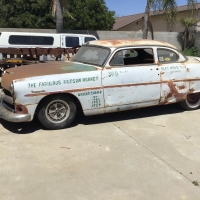Interior of 1928 Hudson Sedan
I'm going to need seats with seat belts. Passenger seats too. Door panels can be cut and covered and fastened somehow. Walls cab be covered somehow, so the problem is how to do the somehow with something. The instructions didn't come with the pile of parts. I'm looking for someone to help talk me through the process. Would a wood kit for a Model T sedan help? The steel body by Hudson looks to be very much the same.
So I figure that someone out there can tell me anything I should know.... always optimistic.
/Tom
So I figure that someone out there can tell me anything I should know.... always optimistic.
/Tom
0
Comments
-
Tom, why not mention your rough location? It's possible that -- if we do have any 1928 owners in your area -- they will be inspired to contact you and offer their help, once they know you're in their backyard.
Failing that, you might try looking in the HET roster to find the nearest '28 owner. He/she might either be able to give you the info you need, or might know a fellow '28 owner would could help you.0 -
I'm in North New Jersey. I live in Hopatcong, and the car is now in Boonton.
Some specific questions about the insides. "How I did it" replies would be the best kind of advice.
What pair of aftermarket seats are suitable of the front seats of this car? They should be adjustable up/down and back/forward so the driver can see over the hood, accommodate belts and actually reach/use the pedals comfortably while still viewing the overhead intersection lights. I want to drive this car routinely. Eventually I will care about the upholstery fabric and color. Arm rests would be nice. This is not a simple request and needs to be an appropriate selection when I buy them. And this is why I'm looking for a success story from another Hudson owner.
What fasteners can I use to secure the replacement door panels on? Which ones do I use and where do they go?
Where do I find a dimensioned drawing of where the interior wood fits, the length of the pieces, shape and how they bolt to the body?
Seems that only Fordor parts are common. Are there Fordor rear seats that will fit? and where do I find whatever I'm looking for?
Does the firewall need insulation for thermal or noise barrier? If so, what to use?0 -
OK? Please don't take offence but there are not near the vendor resources for
Hudson that there are for Ford. There is no catalog to order a complete interior from for example. With a Hudson there are many fewer cars around so the resources are the folks that own the unique beasts. That said I enjoy the hunt for parts and the learning experience of restoring these cars. So I hope I have not dampened your enthusiasm for the car but this is not a catalog car like some of the Fords. With that some of the Ford parts can be made to fit and look fine. I have an open 1928 and the wooden bows from the Fords I made work. I have no idea about the closed cars.Jay
0 -
Here are pics of the interior of two '28 Hudsons I have done.0
-
You won't find any "bolt-in" frames or seats to fit a Hudson. It's a case of "follow your nose" and work it out.0
-
Just a warning: cars in 1928 were not like cars today. They had fewer creature comforts, weren't as safe, and needed a lot more maintenance. As far as I know the seats didn't even adjust fore and aft, as they would later do in the 1930's. If you can find a local owner of a '28 he or she may be able to give you a lot of information -- if the owner restored his car himself, that is. As to finding seats that adjust every which-way, you may simply have to "go modern" (that is, explore a junkyard for what you want) but I'm afraid that with too much modern stuff, the car is soon going to lose its 1920's charm!
To answer one of your questions: there are no drawings available of the woodwork in the car. I'm almost sure of it. Unless of course some recent owner of a '28 decided to draw them up. I know that in the 1929's, for example, there is very little wood used for structural framing. Just for the roof. Most cars of that era had elaborate wood frameworks, to which the steel body panels were nailed or screwed. Hudson was getting away from that in the late 1920's, but companies like GM stubbornly stuck with wooden frames until the early to mid 1930's.
By the way, I know a very good long-time Hudson mechanic who lives in Parsippany -- Mike Gajdek -- and would be glad to give you his contact information. I honestly don't know how much he knows about the mechanics of the 1920's cars, but from the 1930's up, he's very adept. He doesn't have a restoration facility with employees or anything, but he can work wonders on Hudson engines!0 -
Geoff, You do beautiful work, and should be very proud of these restorations. The surfaces are flat and smooth, no wrinkles or puckers. Neat. Maybe the key to success is to "follow your nose", as you suggest. I know that there was wood in back of the rear seat, and to the sides too in all these cars through at least 1932. The vacuum cleaner took out little pieces hanging from the walls. I know the wall fabric attached to them, and maybe along the top edge of the inside roof. I'm assuming that there were verticals somewhere. I need to know where the fabric walls attached and I'll put some wood there. So I was hoping that someone had pictures of the interior supporting structure or photos of work in progress.
This image is the wood of a Murray body 1931 Model A Ford. I think the verticals and upper rail were used as tack strip for the interior fabric walls. Geoff, is that how its done?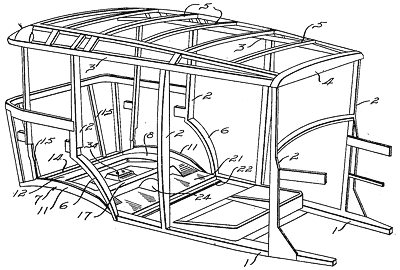
Maybe I should take off work and visit a car upholsterer if I could find one that has worked on old cars. Hummm, probably not in New Jersey. Nothing is in New Jersey.
The only thing I've come across are assembly and parts diagrams of various custom bodies for the Model A Ford. I'm loath to use anything Ford.0 -
Tom,A couple of ideas, that may or may not yield some helpful informationPossibly you could find some construction details in Hudson's (and Essex's) patents from the era - though the existence of a patent doesn't really say anything beyond that people at Hudson toyed with ideas of how to do this or that.For example, there's a number of patents by Millard H. Toncray (at Hudson), that have to do with seats. One of the designs has dual chairs rather than a bench seat in the front, another mentions an adjustable front seat, that can slide forward and up at the same time (IIRC, Don Butler mentions this feature in his book, but it might've been on a later model), and in a third the angle of the seat back is adjustable. If you'd decide to go for a sorta period appropriate seat design based on ideas that Hudson came up with but perhaps never used, these patents could provide a starting point.Here's one of the patent drawings, for example:
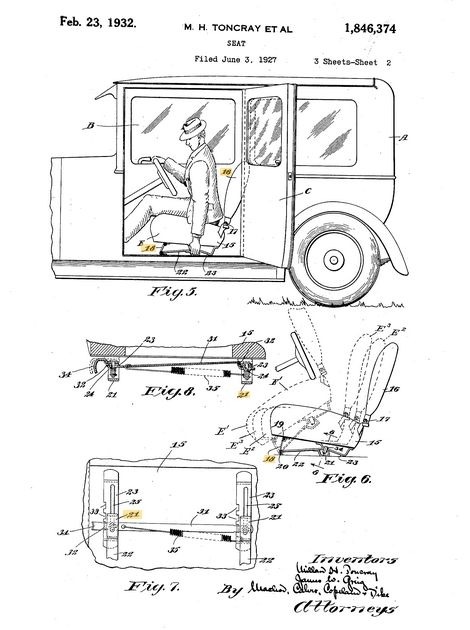 The other thing, is that I recently stumbled on a book title on ebay, "Essentials of Upholstery & Trim for Vintage & Classic" by Lee Jordan Locke. I googled it and found that it's said to be based on a 1920s manual on car upholstery. Perhaps someone reading this knows if it might be helpful to you? Or you could use inter-library loan to check it out.0
The other thing, is that I recently stumbled on a book title on ebay, "Essentials of Upholstery & Trim for Vintage & Classic" by Lee Jordan Locke. I googled it and found that it's said to be based on a 1920s manual on car upholstery. Perhaps someone reading this knows if it might be helpful to you? Or you could use inter-library loan to check it out.0 -
Thanks for the ideas Anna. The book is $!4.99 on Amazon. I think I'll buy it.
The front seat in my car was adjustable in front/back as there was a metal pull rod, rusty spring and a ratchet-looking sheet metal part attached to a piece of wood that had a front hole in it that was over a hex headed tall bolt in the floor. Assuming that the seat could be removed and then positioned back on these locating pins. How the seat went together with the rusty springs, I have no idea. I don't think the seat back folded or was adjustable. But, what do I care? I want to drive the car every day, not an historical museum piece, although its going to look like one. Not going to spend $300 remanufacturing an uncomfortable seat. I'm going to buy a suitable seat and am hoping that someone who drives a hot rod can suggest a decent seat that sorta/kinda looks period. Maybe this is the wrong forum for seats, but the right forum for the interior.
Oh, while I'm thinking of it. What can anyone tell me about the read window seal?0 -
Oops, that should have been rear window seal.0
-
Can't find any pics of car wood for any make of sedan. Talked to an upholsterer who worked on a sedan some years ago, and he said that the wood is critical to fasten the interior fabric. An so must run around the upper roof around the rear window and in back of the 'C' post, along with both sides of the corners. Makes sense to me.
That means there are two vertical full height beams on each side wall, and same on each side of the rear window for a total of 8. Then I need 8 straight connectors between. and 4 curved at the corners, plus two straight above and below the window. Fine. Except that the verticals are not straight because the body is curved near the floor. So, I'm just going to cut wood and fit it in, fasten it to the sheet metal and not worry about how its supposed to be done. Who cares anyway since it will eventually be covered. I guess none of you dear readers thought of taking progress pics when working on your cars. Ah, opportunities missed.0 -
I'm going to be dealing with the same guess-work on my 29 coupe. I do have a few pieces of rotten wood that may give me some clues when the time comes...0
-
Geoff, are the wooden parts of 28 and 29 the same, or even similar?0
-
No, wood parts are different '28 and '29. '29 standard sedans have rear quarter window and smaller rear window than '28 models.0
-
Hummm. Before I go ahead and cut wood, how does the rear bench seat fasten to anything? There is Thea metal base, but how does that help anything? Seat end plates can screw into the wood through the wall fabric, but does the seat back fasten somehow to the rear window horizontal or the four verticals on the back? How to do it? Can't put in a bolt through the upholstery. Geoff, I need your advice again.0
-
The seat back is attached to the steel bottom frame by simple hinges screwed to the bottom board of the back, and the back rests against the frame below the rear window.
This way you can swing the rear of the seat forward slightly to get in behind it. There was originally a fibre board sheet resting against the rear steel of the body to act as an insulator. There is room to fit bits and pieces behind the seat. I have an axle shaft, starter, generator, and head gasket tucked in here, and in the recesses each side of the squab I have a coil, distributor, wheel puller, two con rods, spare bulbs, etc. My Essex is a coach, so under the drivers bucket seat I have a jack and handle, crank handle, flat tool kit between the seats, and a plain radiator cap that I fit when the car is parked so people don't steal the flying man. The rear squab has holes in the bottom frame that fit over knobs in the framework of the rear floor.0 -
It will be good when the 16-29 group is running again. Hope this info is of help
0 -
Its freezing cold outside, so I thought it would be more productive to bring the front doors into the house. Not entirely sure this was a good idea for logistical reasons, but they are here. I took pictures of the various window edges thinking it would be a good start to do the wood first. However, it is not straight forward just where and how the wood is to be attached, nor the shapes required. I need something to go by. As I see it, the pieces go on in a specific order:
1. The sill. Runs completely from extreme left to extreme right. I should plan the width so there is an overhang, or about 2.0". That would put the outer edge about 1/8 past the door panel, I think. The thickness appears to be about 3/8", and fastens with four screws of some type into female threaded rivets. I think these used too be 8-32 but are filled with rust and dirt now. Is this correct so far?
On the metal ledge where the sill attaches, there are four indented areas about 1-1/2" wide going over the edge. (See attached pic.) Something was supposed to go there for some unknown purpose. Could this have something to do with the door panel, or was it to fasten a drop wood horizontal slat. (I know some cars had that, but did the Hudson?) Please advise.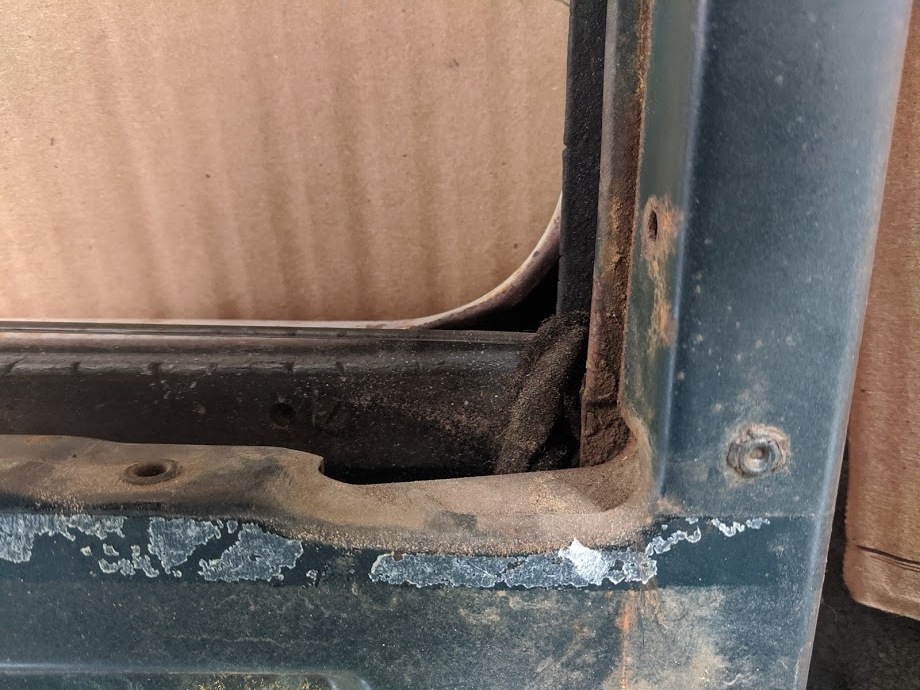
2. The side wood verticals are tapered? There is a fastening point, but only near the bottom, so that won't work. Here is a picture of the entire right side without places to fasten anything.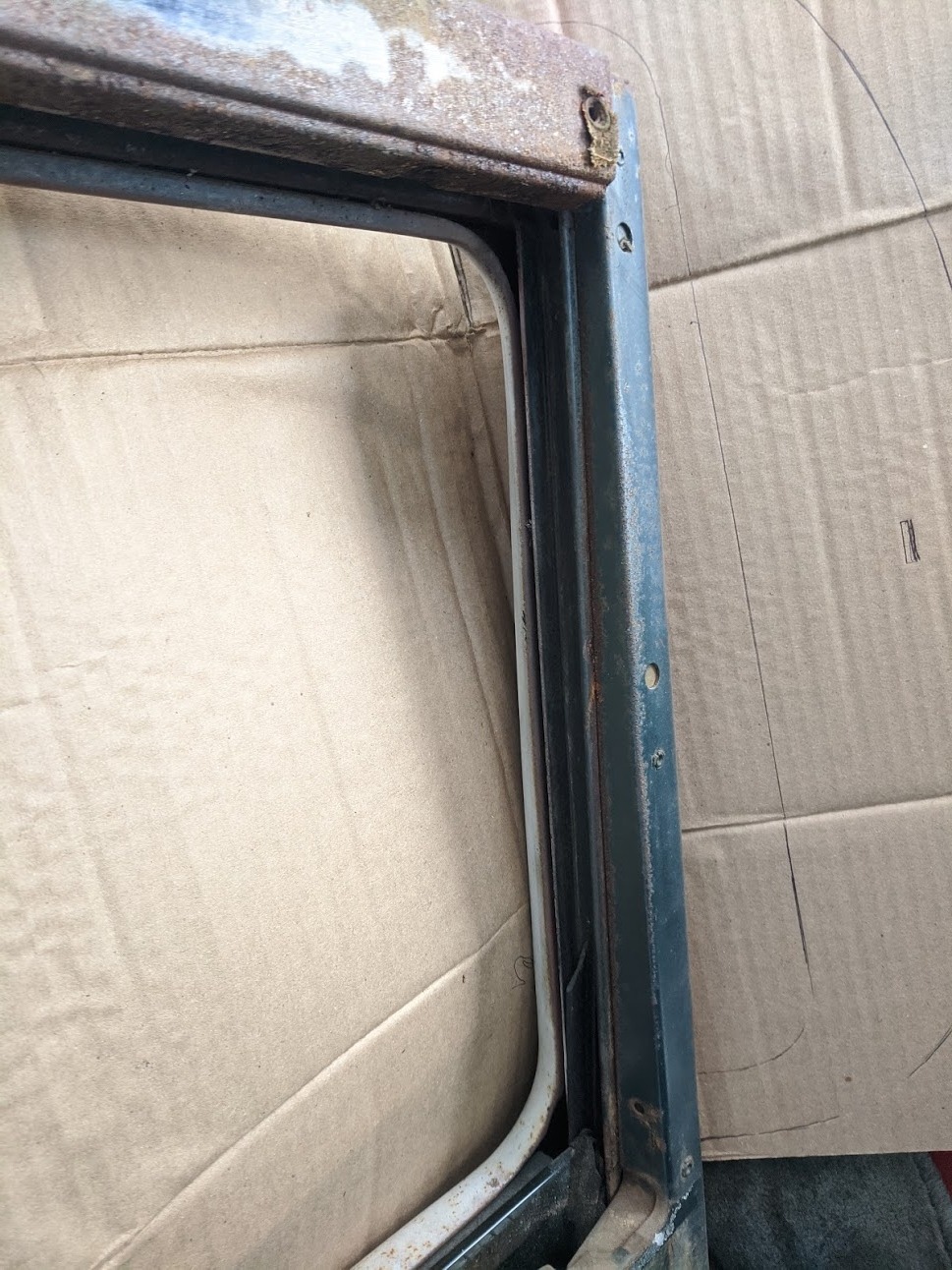
3. The vertical faces of the frame sides along the wood have round holes, hex holes and rivets, Doesn't look like there are attachments for wood, but along the top of the door, there is a center metal piece that sticks out hinting that a wood piece abuts and fastens on the green metal face. (See pic.) What gives?
See the remnants of threads at the top? Canvas looking, not the same as the remaining mohair upholstery. Could this be a door seal? The metal piece is not firmly attached, but it doesn't want to come off.
4. No holes at the top inside frame to attach wood, so I suppose there isn't any? Doesn't seem right to me. And, BTW, looks like there are pieces of wood inside the fetal frame. No holes in the wood either.
5. Is there supposed to be a facing wood slat over the top center metal piece? Looks like threaded rivets in the pic. Please advice verbosely.
0 -
There is no wood in the door as at all. The upholstery is glued to the top metal and side frames. The window surrounds are metal, and artificial wood-grain.0
-
Then the metal framing pieces are all missing. I don't understand how someone could throw them away. Now how to solve this. Maybe thin hardwood flooring?0
-
Anyone know what type of wood was used. (Ash, walnut, etc?)0
-
I think ash was used for structural framing in the old cars. But by 1929 (if not earlier), Hudson had mostly abandoned structural wood framing. Only the roof and top rails were wood. From there on down, wood was only used for tacking strips (for upholstery). Ford and GM continued to use wooden body frames until the mid-1930's.0
-
As I said before, there is no wood in a Hudson door. There are metal trim pieces that the fabric is glued to, and screw into the door frame. The window surrounds are artificial wood grain (Paint).)0
-
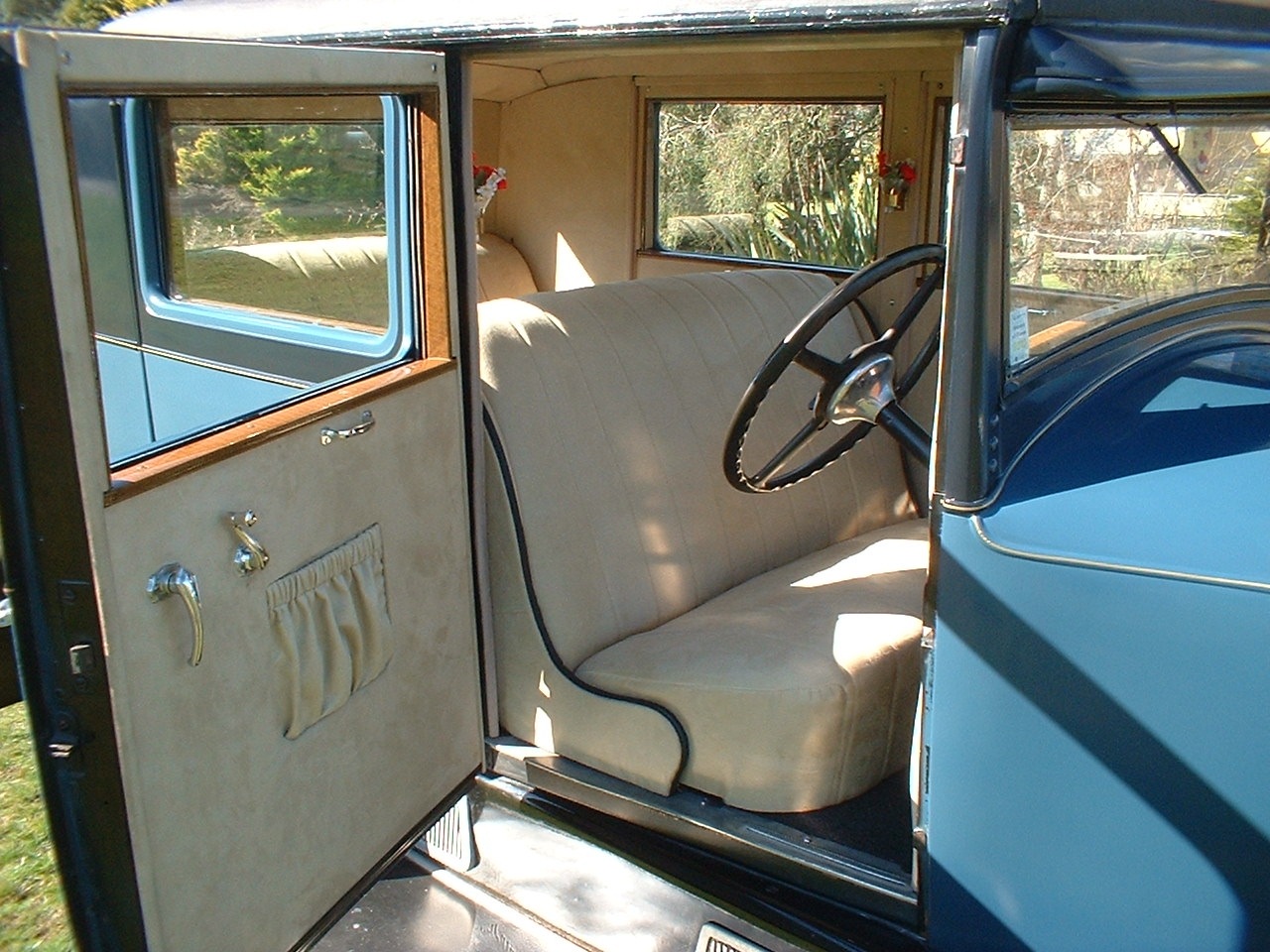
0 -
I'm still doing the interior, or working on it. There are many details I'm discovering later in the process than I should have. Just found a web site that tells all that is needed to know, or at least I think. It shows a ledge cut into the rim roof wood to accommodate staples needed for the head liner and the cloth that wraps the long upper corner running over the doors. I wish that I had known about that before now. But for the benefit of those doing this kind of work in the future, see here:
https://www.classtiqueupholstery.com/index.php/installation-videos
A must see for installing the headliner and tacking it into the side ledge cut, see:
https://www.youtube.com/watch?v=eecKhRb3D8c&feature=youtu.be
and watch the entire video. Yes, it's written for a Ford car, but listen anyway because the roof and headliner are installed in identical manners.0
Categories
- 36.9K All Categories
- 113 Hudson 1916 - 1929
- 20 Upcoming Events
- 93 Essex Super 6
- 28.6K HUDSON
- 574 "How To" - Skills, mechanical and other wise
- 995 Street Rods
- 151 American Motors
- 180 The Flathead Forum
- 49 Manuals, etc,.
- 78 Hudson 8
- 44 FORUM - Instructions and Tips on using the forum
- 2.8K CLASSIFIEDS
- 608 Vehicles
- 2.2K Parts & Pieces
- 77 Literature & Memorabilia
- Hudson 1916 - 1929 Yahoo Groups Archived Photos


